We boarded a skiff to take us to the river boat.
And there is our home for the next 6 nights.
Once on board Jose' introduced us to the ship captain and the Naturalist, Edgard, who will be our resource for all activities while on the river.
Here's a few photos of the river boat accommodations.
Our cabin was at the very front of the river boat and we had this bench outside our room to sit and enjoy the view.
A perfect spot to watch the river drift by.
After lunch and some unpacking of the luggage, Naturalist Edgard led us in a Learning and Discovery of the Amazon fruits.
1. Anona - Soursop-related to the Chinimoya that we tasted in Lima.
2. Macambo--nicknamed "monkey brain. It is related to cocoa beans
3, Huito-Genipa, which we tried boiled.
4, Uvilla, also called "Wild Grapes"
5. Passion fruit used for ice cream and drinks
6. Camu camu
7. Mullaca or "Jungle candy". It is sweet.
8. Cocona - yellow tomato. Used to control diabetes and for hot sauce.
Some were good; some were not, and I don't remember which is which.
After the fruit demonstration, we did our first skiff ride to look for wildlife on the Nauta Cayon. We take the skiffs out to explore on the smaller rivers. And, as dusk is approaching, it is a perfect time to watch the wildlife.
We slowly cruised along the river bank looking up in the trees and along the banks for birds.
We saw a sloth high up in a tree.
We saw many birds; they were hard to photograph and as it became dusk, they were just silhouettes in the camera view.
We did see a small Spectacle caiman as it was trying to hide in the mud.
For our birder friends, I will list what we saw: Great Egrets, Snowy Egrets, White trouted tucan, Cocoi heron, Horn Screamer, Ring King Fisher, Grest Keeskidee (fly catcher), Yellow billed tern, Black collared hawk, Capped heron and a Cocoi heron. This trip would definitely be a birder's paradise.
The next morning we saw an iguana on the bank right off the side of the riverboat.
After breakfast we boarded the skiffs to go Piranha fishing! We headed up a little river.
Tied up to the shore
Baited the hooks with filet mignon, those lucky piranha!!And dropped the hook into the water.
We could watch the piranha taking the bait very quickly. Usually the hook came up bare so we rebaited and rebaited many times.
Terry caught his first piranha!
The piranha was actually just a few inches long. Jose' showed us how to trick the camera for a photo!
I was unable to actually land a piranha in the boat. I had 3 on the hook but they dropped back into the water before I could get them in the boat. But, our group caught a total of 16 piranhas and released about 6 or 7 more. It was a fun experience.
The riverboat's chef prepared the piranha for us to try at dinner.
They do have sharp teeth!And I did try one...very little meat on these little fish...but they sure do have a ferocious appetite for filet mignon!
Later in the morning Edgard briefed us on where and what we will be doing while cruising on the rivers during his Map Orientation.
Here's a photo of the map of the Peruvian rivers in the Amazon basin.
It is typically too hot to be outside much between noon and 3 pm. So it's a great time to take a snooze.
So it is not until just after 3:00 that we boarded the skiffs to go on a hike in the jungle.
The riverboat is near a rangers' station. This is the rangers' boat that was tied on shore when the river level was high. They must have left the station for a couple weeks and when they returned they found the river level was low...but their boat remained stuck high on the bank. They will have to wait until the high-water season to use that boat again.
We rode in the skiffs to where we would start the hike.
We walked only a short distance and learned we had to cross this lake.
We rode in what they call a catamaran. It was 2 row boats connected together with 2 wooden planks.
There were 4 paddles in the catamaran so we all took turns with the paddling.
This is a termite mound attached to a tree trunk.
This is a rubber tree. It was these trees that facilitated the Rubber Boom era in South America.
The Amazon Rubber Boom took place between 1855 and 1920 when the Amazon was the sole supplier of raw rubber. This was a horrible period of time for the indigenous people as they were treated as slave labor and mistreated.
Here's a closer look of the rubber leaking in white streaks from the right side of the tree.
Our first suspended bridge.
Only 4 people could be on it at one time.
I'm almost across. There were a total of 8 bridges we crossed.
Here's Terry finishing up the last bridge crossing. It was an extremely hot and humid 3-hour hike!
We returned to the catamarans and saw the first group take off. In minutes we saw that they were paddling right into a rain storm.
The rain is starting to come down on us. We quickly dug out our rain ponchos and covered up the cameras. We didn't mind the rain; we are in the rain forest after all. And it was actually a great way to cool off.
By the time we made it across the lake, the rain stopped and the skies were clearing.
That evening before dinner we were entertained by members of the boat crew. They called themselves the "Chonky Monkies". They were very good.
Jose' got everyone up dancing to the music. We had a great time.
We are up early the next morning in hopes of seeing the river dolphins swimming around the riverboat. There are both gray and pink dolphins in the river, but they are hard to photograph...just too quick. I definitely want to see a pink dolphin!
Right after breakfast Jose' gave us an Express Spanish lesson. He had written out several questions in Spanish and led us through a practice session of pronunciation. The list included questions like: What is your name? What is your age? What is your favorite subject?
The reason for this express Spanish lesson was to enable us to interact with the school children we were going to meet today when we visit a village later in the morning.
But first, while riding in the skiffs to the village, we stopped to meet a local shaman. In the Amazon, shamans perform rituals to induce physical and psychological healing.
We met Carola. With our naturalist, Edgard translating, Carola told us how she heals people through the use of plant medicines and spirits.
Here she is showing us her necklace made from the plant ayahuasca, an hallucinogenic plant she uses in her healing ritual. The use of the plant remains controversial and is only accessible in the remote regions of the Amazon. We were told people come from all over the world to be healed by the shamans of the Amazon.
This visit was definitely a very interesting "learning and discovery" moment.
The Amazon is the world's largest rain forest with over 300,000 different kinds of plants and trees.
We planted what will become a mango tree.
After the tree planting ceremony we left in the skiffs again and headed to the village of Montealegre to share "A Day in the Life" with this community.
We went to Sra Luisa's house where we will have lunch later today. She gave us a cooking lesson.
She put rice, cooked chicken, corn, and some kind of fruit onto a huge palm leaf and wrapped it up to finish cooking.
She ties it off with a length of palm leaf fiber
She then invited one of our travelers to prepare the same.
She did great; and here is a bowl filled with other portions ready to go on the grill to finish cooking.We then visited Sra Luisa's daughter. She showed us how she manufactures baskets from palm tree fiber and natural dyeing substances.
To create the yellow dye, she grates tumeric and adds water to form a paste.
She showed us how she made 3 different colors.
And here are some of the baskets she has made.
We left Sra Maria and explored the village a bit. Here's the village church.
And some of the homes. The village consists of 22 families--about 104 people.
The inside of a home.
The children of this elementary school were all lined up waiting for us.
Jose' helped as each student introduced themselves by giving their name, their age, their grade, and what they hope to be when they grow up.
We also introduced ourselves, pointing onto a map of the United States where we lived. The students practiced their English by repeating our names and state.It was then time to interact with the kids individually and practice the Spanish we learned earlier this morning.
I visited with Ariana. She is 7 years old and in grade 2; she proudly showed me her notebook. I learned that her favorite subject is mathematics.
Terry visited with Willy. He is in 6th grade. Next year he will need to travel to another village for school every day. Many of the students paddle a canoe on the river to get there.
The students then surprised us by singing a song.
And we surprised them by getting up and singing "Hokey Pokey" (because everyone knows that song) and having the children dance with us. "You put your right arm in...you put your right arm out.. and you shake it all about". Got that song running through your head now?
We ended our visit to the school by having a group photo taken with the children.
It was time to head back to Sra Luisa's house for the lunch she has prepared. But first we stop by what Jose calls the "Jungle WalMart".
The baskets were a big hit. One of our travelers bought at least 3 during the course of this trip.
The food was laid out on the floor, buffet style.
There were juices to try. The tour company has very strict guidelines for these Home-hosted meals. We are assured there is no fear of eating something that was not properly washed and prepared.It was quite the feast and all very good.....especially the chicken and rice baked in the palm leaf.
Back on the boat, we gathered on the upper deck and enjoyed the view as the riverboat cruised along. We all had our binoculars out in hopes of seeing some macaws in the trees in the late afternoon.
That was not successful...
But we did see villagers enjoying swimming to cool off after a hot, humid day.
And we enjoyed a most wonderful sunset in the Amazon River basin.
That evening the crew entertained us again.
While we enjoyed the best ever pisco sours, the national drink of Peru.
Meals on the riverboat were always served buffet style. The food was quite good and always featured fish, chicken, vegetables and fruit.
We have three more days on the river, with more incredible experiences, like getting up close to an anaconda, a tarantula, trees that are 180 feet tall and more. To continue reading, scroll down and click on "Newer Post".

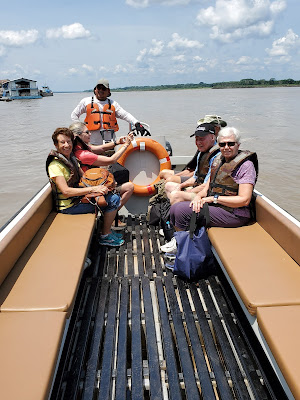




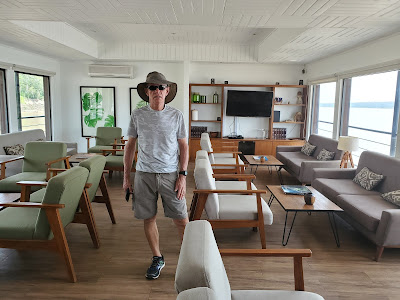




















































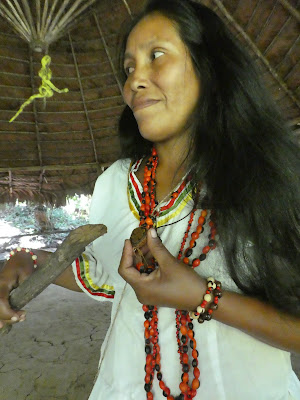










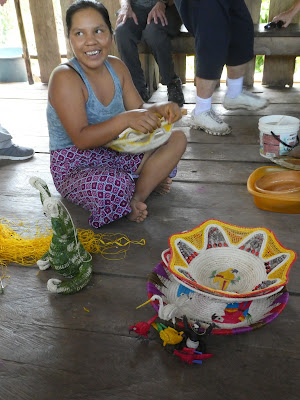










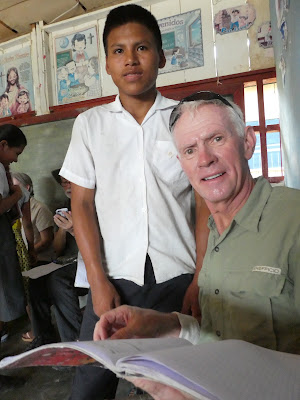



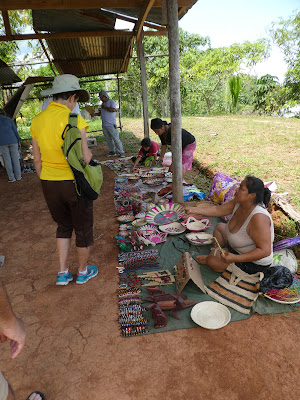








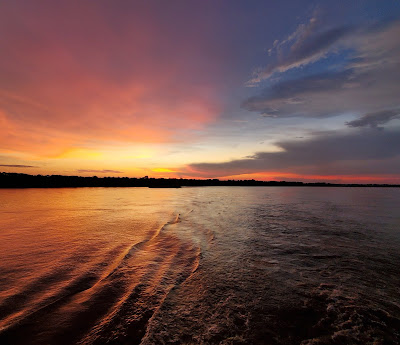





No comments:
Post a Comment